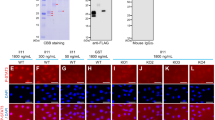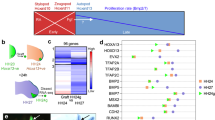Abstract
Retinoids regulate gene expression through the action of retinoic acid receptors (RARs) and retinoid-X receptors (RXRs), which both belong to the family of nuclear hormone receptors1,2. Retinoids are of fundamental importance during development2, but it has been difficult to assess the distribution of ligand-activated receptors in vivo. This is particularly the case for RXR, which is a critical unliganded auxiliary protein for several nuclear receptors, including RAR1, but its ligand-activated role in vivo remains uncertain. Here we describe an assay in transgenic mice, based on the expression of an effector fusion protein linking the ligand-binding domain of either RXR or RAR to the yeast Gal4 DNA-binding domain, and the in situ detection of ligand-activated effector proteins by using an inducible transgenic lacZ reporter gene. We detect receptor activation in the spinal cord in a pattern that indicates that the receptor functions in the maturation of limb-innervating motor neurons. Our results reveal a specific activation pattern of Gal4–RXR which indicates that RXR is a critical bona fide receptor in the developing spinal cord.
This is a preview of subscription content, access via your institution
Access options
Subscribe to this journal
Receive 51 print issues and online access
$199.00 per year
only $3.90 per issue
Buy this article
- Purchase on Springer Link
- Instant access to full article PDF
Prices may be subject to local taxes which are calculated during checkout




Similar content being viewed by others
References
Manglesdorf, D. J. & Evans, R. M. The RXR heterodimers and orphan receptors. Cell 83, 841–850 (1995).
Kastner, P., Mark, M. & Chambron, P. Nonsteroid nuclear receptors: what are genetic studies telling us about their role in real life? Cell 83, 859–869 (1995).
Marshall, H. et al. Aconserved retinoic acid response element required for early expression of the homeobox gene Hoxb-1. Nature 370, 567–571 (1994).
Kastner, P. et al. Genetic evidence that the retinoid signal is transduced by heterodimeric RXR/RAR functional units during mouse development. Development 124, 313–326 (1997).
Dupé, V. et al. In vivo functional analysis of the Hoxa-1 3′ retinoic acid response element (3′ RARE). Development 124, 399–410 (1997).
Wagner, M., Thaller, C., Jessell, T. M. & Eichele, G. Polarizing activity and retinoid synthesis in the floorplate of the neural tube. Nature 345, 819–822 (1990).
Horton, C. & Maden, M. Endogenous distribution of retinoids during normal development and teratogenesis in the mouse embryo. Dev. Dynam. 202, 312–323 (1995).
Durand, B. et al. Activation function 2 (AF2) of retinoic acid receptor and 9-cis retinoic acid receptor: presence of a conserved autonomous constitutive activation domain and influence of the nature of the response element on AF-2 activity. EMBO J. 13, 5370–5382 (1994).
Yang, Y., Minucci, S., Ozato, K., Heyman, R. A. & Ashwell, J. D. Efficient inhibition of activation-induced Fas ligand up-regulation and T cell apoptosis by retinoids requires occupancy of both retinoid X receptors and retinoic acid receptors. J. Biol. Chem. 270, 18672–18677 (1995).
Roy, B., Taneja, R. & Chambon, P. Synergistic activation of retinoic acid (RA)-responsive genes and induction of embryonal carcinoma cell differentiation by an RA receptor α (RARα)-, RARβ-, or RARγ-selective ligand in combination with a retinoid X receptor-specific ligand. Mol. Cell. Biol. 15, 6481–6487 (1995).
Bissonnette, R. P. et al. 9-cis retinoic acid inhibition of activation-induced apoptosis is mediated via regulation of fas ligand and requires retinoic acid receptor and retinoid X receptor activation. Mol. Cell. Biol. 15, 5576–5585 (1995).
Botling, J., Castro, D. S., Ösberg, F., Nilsson, K. & Perlmann, T. RAR/RXR heterodimers can be activated through both subunits providing a basis for synergistic transactivation and cellular differentiation. J. Biol. Chem. 272, 9443–9449 (1997).
Minucci, S. et al. Retinoid X receptor (RXR) within the RXR–retinoic acid receptor heterodimer binds its ligand and enhances retinoid-dependent gene expression. Mol. Cell. Biol. 17, 644–655 (1997).
Lu, H.-C., Eichele, G. & Thaller, C. Ligand-bound RXR can mediate retinoid signal transduction during embryogenesis. Development 124, 195–203 (1997).
Allenby, G. et al. Retinoic acid receptors and retinoid X receptors: interactions with endogenous retinoic acids. Proc. Natl Acad. Sci. USA 90, 30–34 (1993).
Zimmerman, L. et al. Independent regulatory elements in the nestin gene direct transgene expression to neural stem cells or muscle precursors. Neuron 12, 11–24 (1994).
Rossant, J., Zirngibl, R., Cado, D., Shago, M. & Giguère, V. Expression of a retinoic acid response element–hsplacZ transgene defines specific domains of transcriptional activity during mouse embryogenesis. Genes Dev. 5, 1333–1344 (1991).
Reynolds, K., Mezey, E. & Zimmer, A. Activity of the β-retinoic acid receptor promoter in transgenic mice. Mech. Dev. 36, 15–29 (1991).
Mendelsohn, C., Ruberte, E., LeMeur, M., Morriss-Kay, G. & Chambon, P. Developmental analysis of the retinoic acid-inducible RAR-β2 promoter in transgenic animals. Development 113, 723–734 (1991).
Wagner, M. & Jessell, T. M. Regional differences in retinoid release from embryonic neural tissue detected by an in vitro reporter assay. Development 116, 55–66 (1992).
Colbert, M. C., Linney, E. & LaMantia, A.-S. Local sources of retinoic acid coincide with retinoid-mediated transgene activity during embryonic development. Proc. Natl Acad. Sci. USA 90, 6572–6576 (1993).
Sockanathan, S. & Jessell, T. M. Motor neuron-derived retinoid signaling specifies the subtype identity of spinal motor neurons. Cell 94, 503–514 (1998).
McCaffery, P. & Dräger, U. C. Hot spots of retinoic acid synthesis in the developing spinal cord. Proc. Natl Acad. Sci. USA 91, 7194–7197 (1994).
Wang, X., Penzes, P. & Napoli, J. L. Cloning of a cDNA encoding an aldehyde dehydrogenase and its expression in Escherichia coli. Recognition of retinal as substrate. J. Biol. Chem. 271, 16288–16293 (1996).
Zhao, D. et al. Molecular identification of a major retinoic-acid-synthesizing enzyme, a retinaldehyde-specific dehydrogenase. Eur. J. Biochem. 240, 15–22 (1996).
Niederreither, K., McCaffery, P., Dräger, U. C., Chambon, P. & Dollé, P. Restricted expression and retinoic acid-induced downregulation of the retinaldehyde dehydrogenase type 2 (RALDH-2) gene during mouse development. Mech. Dev. 62, 67–78 (1997).
Perlmann, T. & Jansson, L. Anovel pathway for vitamin A signaling mediated by RXR heterodimerization with NGFI-B and Nurr1. Genes Dev. 9, 769–782 (1995).
Nilsson, E. & Lendahl, U. Transient expression of a human β-actin promoter/lacZ gene introduced into mouse embryos correlates with a low degree of methylation. Mol. Repr. Dev. 34, 149–157 (1993).
Lumsden, A. G. S. & Davies, A. M. Earliest sensory nerve fibres are guided to peripheral targets by attractants other than nerve growth factor. Nature 306, 786–788 (1983).
Zetterström, R., Solomin, L., Mitsiadis, T., Olson, L. & Perlmann, T. RXR heterodimerization and developmental expression distinguish the orphan nuclear receptors NGFI-B, Nurr1 and Nor1. Mol. Endocrinol. 10, 1656–1666 (1996).
Mascrez, B. et al. The RXRα ligand-dependent activation function 2 (AF-2) is important for mouse development. Development (in the press).
Acknowledgements
We thank S. Sockanathan, T. Jessell and P. Chambon for communicating unpublished results and for discussion; T. Jessell and P. Ljungdahl for Islet-1 and HA antibodies; A.Mata for transfections; E. Nilsson, K. Jansson, Karin Lundströmer and E. Lindqvist for technical support; L. Foley for SR11237; and R. Pettersson for comments. This work was supported by the Swedish Medical Research Council, and the US Public Health Service.
Author information
Authors and Affiliations
Corresponding author
Rights and permissions
About this article
Cite this article
Solomin, L., Johansson, C., Zetterström, R. et al. Retinoid-X receptor signalling in the developing spinal cord. Nature 395, 398–402 (1998). https://doi.org/10.1038/26515
Received:
Accepted:
Issue Date:
DOI: https://doi.org/10.1038/26515
This article is cited by
-
Unsupervised automated high throughput phenotyping of RNAi time-lapse movies
BMC Bioinformatics (2013)
-
All-trans retinoic acid induces COX-2 and prostaglandin E2 synthesis in SH-SY5Y human neuroblastoma cells: involvement of retinoic acid receptors and extracellular-regulated kinase 1/2
Journal of Neuroinflammation (2007)
-
Vitamin A active metabolite, all‐trans retinoic acid, induces spinal cord sensitization. I. Effects after oral administration
British Journal of Pharmacology (2006)
-
Reporter mice and drug discovery and development
Nature Reviews Drug Discovery (2005)
-
Principles for modulation of the nuclear receptor superfamily
Nature Reviews Drug Discovery (2004)
Comments
By submitting a comment you agree to abide by our Terms and Community Guidelines. If you find something abusive or that does not comply with our terms or guidelines please flag it as inappropriate.



